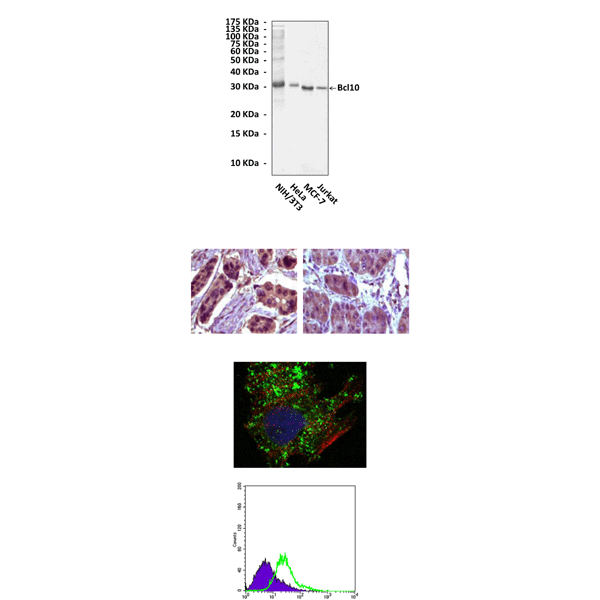BACKGROUND Bcl10 (B-cell CLL/lymphoma 10) was identified by its translocation in a case of mucosa-associated lymphoid tissue (MALT) lymphoma. The protein encoded by this gene contains a caspase recruitment domain (CARD), and has been shown to induce apoptosis and promote pro-caspase-9 maturation and to activate NF-kB via NIK and IKK.1 Bcl10 may be an adapter protein between upstream TNFR1-TRADD-RIP complex and the downstream NIK-IKK-IKAP complex. It is reported to interact with other CARD domain containing proteins including CARD9, 10, 11 and 14, which are thought to function as upstream regulators in NF-kB signaling.2 This protein is found to form a complex with MALT1, a protein encoded by another gene known to be translocated in MALT lymphoma. It is a substrate for MALT1. MALT1 and Bcl10 are thought to synergize in the activation of NF-kB, and the deregulation of either of them may contribute to the same pathogenetic process that leads to the malignancy.3
RECENT PUBLICATION
Conroy, B., T. Herek., T. Shew, M. Latner, J. Larson, L. Allen, P. Davis, T. Helikar, and C. Cutucache. 2014. Design, Assessment, and in vivo Evaluation of a Computational Model Illustrating the Role of CAV1 in CD4+ T-lymphocytes. Front Immunol, 5:599.
REFERENCES
1. Wang, L. et al: J. Biol. Chem. 276:21405-9, 2001
2. Zhou, H. et al: Nature 427:167-71, 2004
3. Lucas, P. C. et al: J. Biol. Chem. 276:19012-19, 2001
Products are for research use only. They are not intended for human, animal, or diagnostic applications.
Cat.No.: | CP10022 |
Antigen: | Purified recombinant human Bcl10 protein fragments expressed in E. coli. |
Isotype: | Mouse IgG1 |
Species & predicted species cross- reactivity ( ): | Human, Mouse |
Applications & Suggested starting dilutions:* | WB 1:500 - 1:2000 IP n/d IHC 1:200 - 1:1000 ICC 1:200 - 1:1000 FACS 1:200 - 1:400 |
Predicted Molecular Weight of protein: | 31 kDa |
Specificity/Sensitivity: | Detects endogenous Bcl10 proteins in normal cell lysates without cross-reactivity with other family members. |
Storage: | Store at -20°C, 4°C for frequent use. Avoid repeated freeze-thaw cycles. |
*Optimal working dilutions must be determined by end user.









